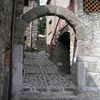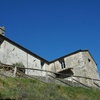Castle of Lucignana
The fortress of Lucignana, which rises on the top of a rocky ridge, is mentioned for the first time in a document from 1048 in which it is listed as among the properties of the Rolandinghi.
Few traces of the of castle Lucignana are visible, and it is only recognisable in the arch of the gateway to the castrum, some parts of the perimeter walls and the remains of a square tower with an arched opening.
The parish Church , dedicated to Saint Stephen, still retains some of its mediaeval structure despite repeated restorations which occurred in the following centuries. Inside there is the Stoning of St. Stephen by Ippolito Sani (XVII cent.)
Not far from Lucignana, nestled in the holm oak woods, lies an easily walkable path (20 minutes) which leads to the Hermitage of Sant'Ansano, a place of worship built in the Middle Ages and restored and expanded in the eighteenth century.
Historical notes
Sources reported on the fate of the castle during the thirteenth and fourteenth centuries, when new wars stirred in Garfagnana and the Media Valle del Serchio. Veltro Baronciulli's decision to move "into castro Licignane" in order to lead a simple peasant life in the country after the rebellion of Sedona against the city of Lucca should be considered in this scenario.
In 1331 the tower of Lucignana was destroyed and was paid for by Cambino, "magister legnaminis", who carried out the demolition.










